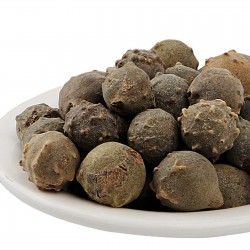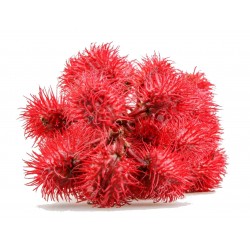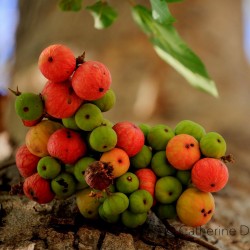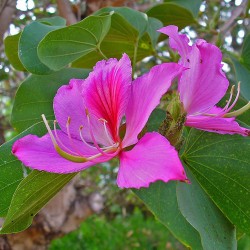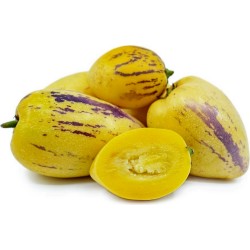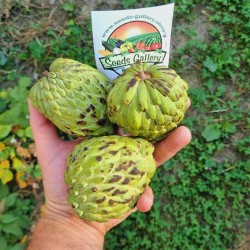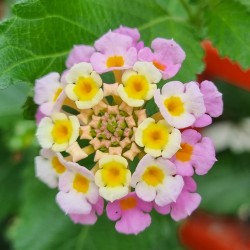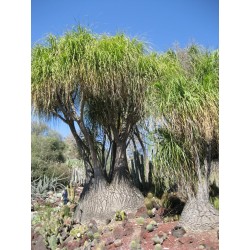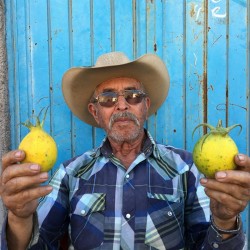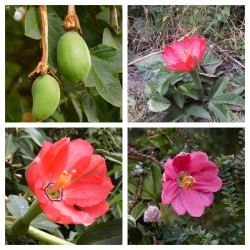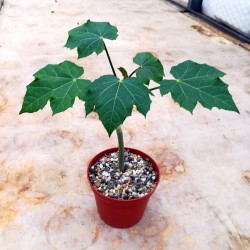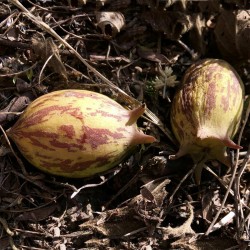Seeds Gallery Com,
5/
5
<h2 class=""><strong>Castor Bean Seeds (Ricinus Communis)</strong></h2>
<h2><span style="color: #ff0000;"><strong>Price for Package of 15 seeds.</strong></span></h2>
<p><i style="font-size: 14px;"><b>Ricinus communis</b></i><span style="font-size: 14px;">, the</span><span style="font-size: 14px;"> </span><b style="font-size: 14px;">castor bean</b><span style="font-size: 14px;"> </span><span style="font-size: 14px;">or</span><span style="font-size: 14px;"> </span><b style="font-size: 14px;">castor oil plant</b><span style="font-size: 14px;">,</span><span style="font-size: 14px;"> </span><span style="font-size: 14px;">is a species of</span><span style="font-size: 14px;"> </span><span style="font-size: 14px;">perennial</span><span style="font-size: 14px;"> </span><span style="font-size: 14px;">flowering plant</span><span style="font-size: 14px;"> </span><span style="font-size: 14px;">in the</span><span style="font-size: 14px;"> </span><span style="font-size: 14px;">spurge</span><span style="font-size: 14px;"> </span><span style="font-size: 14px;">family,</span><span style="font-size: 14px;"> </span><span style="font-size: 14px;">Euphorbiaceae</span><span style="font-size: 14px;">. It is the sole species in the</span><span style="font-size: 14px;"> </span><span style="font-size: 14px;">monotypic</span><span style="font-size: 14px;">genus</span><span style="font-size: 14px;">,</span><span style="font-size: 14px;"> </span><i style="font-size: 14px;"><b>Ricinus</b></i><span style="font-size: 14px;">, and</span><span style="font-size: 14px;"> </span><span style="font-size: 14px;">subtribe</span><span style="font-size: 14px;">,</span><span style="font-size: 14px;"> </span><b style="font-size: 14px;">Ricininae</b><span style="font-size: 14px;">. The evolution of castor and its relation to other species are currently being studied using modern genetic tools.</span><span style="font-size: 14px;"> </span><span style="font-size: 14px;">It reproduces with a mixed pollination system which favors selfing by</span><span style="font-size: 14px;"> </span><span style="font-size: 14px;">geitonogamy</span><span style="font-size: 14px;"> </span><span style="font-size: 14px;">but at the same time can be an out-crosser by</span><span style="font-size: 14px;"> </span><span style="font-size: 14px;">anemophily</span><span style="font-size: 14px;"> </span><span style="font-size: 14px;">(wind pollination) or</span><span style="font-size: 14px;"> </span><span style="font-size: 14px;">entomophily</span><span style="font-size: 14px;"> </span><span style="font-size: 14px;">(insect pollination).</span></p>
<div>
<p>Its<span> </span>seed<span> </span>is the castor bean, which, despite its name, is not a true<span> </span>bean. Castor is indigenous to the southeastern<span> </span>Mediterranean Basin,<span> </span>Eastern Africa, and India, but is widespread throughout tropical regions (and widely grown elsewhere as an ornamental plant).<sup id="cite_ref-Phillips_5-0" class="reference">[5]</sup></p>
<p>Castor seed is the source of<span> </span>castor oil, which has a wide variety of uses. The seeds contain between 40% and 60% oil that is rich in<span> </span>triglycerides, mainly<span> </span>ricinolein. The<span> </span>seed<span> </span>also contains<span> </span>ricin, a<span> </span>water-soluble<span> </span>toxin, which is also present in lower concentrations throughout the plant.</p>
<p>An unrelated plant species,<span> </span><i>Fatsia japonica</i><span> </span>(false castor oil plant), is similar in appearance but is from Japan.</p>
<h2><span class="mw-headline" id="Nomenclature">Nomenclature</span></h2>
<p>The name<span> </span><i>Ricinus</i><span> </span>is a<span> </span>Latin<span> </span>word for<span> </span>tick; the seed is so named because it has markings and a bump at the end that resemble certain ticks. The genus<span> </span><i>Ricinus</i><span> </span><sup id="cite_ref-6" class="reference">[6]</sup><span> </span>also exists in zoology, and designates insects (not ticks) which are parasites of birds; this is possible because the names of animals and plants are governed by different<span> </span>nomenclature codes.<sup class="noprint Inline-Template Template-Fact">[<i><span title="This claim needs references to reliable sources. (October 2017)">citation needed</span></i>]</sup></p>
<p>The common name "castor oil" probably comes from its use as a replacement for<span> </span>castoreum, a perfume base made from the dried<span> </span>perineal glands<span> </span>of the<span> </span>beaver<span> </span>(<i>castor</i><span> </span>in Latin).<sup id="cite_ref-7" class="reference">[7]</sup>It has another common name,<span> </span><b>palm of Christ</b>, or<span> </span><i>Palma Christi</i>, that derives from castor oil's reputed ability to heal wounds and cure ailments.</p>
<h2><span class="mw-headline" id="Description">Description</span></h2>
<p><i>Ricinus communis</i><span> </span>can vary greatly in its growth habit and appearance. The variability has been increased by breeders who have selected a range of cultivars for leaf and flower colours, and for oil production. It is a fast-growing,<span> </span>suckering<span> </span>shrub<span> </span>that can reach the size of a small tree, around 12 m (39 ft), but it is not<span> </span>cold hardy.</p>
<p>The glossy<span> </span>leaves<span> </span>are 15–45 cm (5.9–17.7 in) long, long-stalked, alternate and palmate with five to twelve deep lobes with coarsely toothed segments. In some varieties they start off dark reddish purple or bronze when young, gradually changing to a dark green, sometimes with a reddish tinge, as they mature. The leaves of some other varieties are green practically from the start, whereas in yet others a pigment masks the green color of all the<span> </span>chlorophyll-bearing parts, leaves, stems and young fruit, so that they remain a dramatic purple-to-reddish-brown throughout the life of the plant. Plants with the dark leaves can be found growing next to those with green leaves, so there is most likely only a single gene controlling the production of the pigment in some varieties.<sup id="cite_ref-8" class="reference">[8]</sup><span> </span>The stems and the spherical, spiny seed capsules also vary in pigmentation. The fruit capsules of some varieties are more showy than the flowers.</p>
<div class="thumb tright">
<div class="thumbinner"><img alt="" src="https://upload.wikimedia.org/wikipedia/commons/thumb/2/23/Castor_oil_plant_seeds.jpg/220px-Castor_oil_plant_seeds.jpg" width="220" height="129" class="thumbimage" />
<div class="thumbcaption">
<div class="magnify"></div>
The green capsule dries and splits into three sections, forcibly ejecting seeds</div>
</div>
</div>
<p>The flowers lack petals and are unisexual (male and female) where both types are borne on the same plant (monoecious) in terminal<span> </span>panicle-like<span> </span>inflorescences<span> </span>of green or, in some varieties, shades of red. The male flowers are numerous, yellowish-green with prominent creamy<span> </span>stamens; the female flowers, borne at the tips of the spikes, lie within the immature spiny capsules, are relatively few in number and have prominent red<span> </span>stigmas.<sup id="cite_ref-Brickell_9-0" class="reference">[9]</sup></p>
<p>The fruit is a spiny, greenish (to reddish-purple)<span> </span>capsule<span> </span>containing large, oval, shiny, bean-like, highly poisonous seeds with variable brownish mottling. Castor seeds have a warty appendage called the<span> </span>caruncle, which is a type of<span> </span>elaiosome. The caruncle promotes the dispersal of the seed by ants (myrmecochory).</p>
<h2><span class="mw-headline" id="Medicinal_uses">Medicinal uses</span></h2>
<p>Castor oil<span> </span>has many uses in medicine and other applications.</p>
<p>An alcoholic extract of the leaf was shown, in lab rats, to protect the liver from damage from certain poisons.<sup id="cite_ref-10" class="reference">[10]</sup><sup id="cite_ref-11" class="reference">[11]</sup><sup id="cite_ref-12" class="reference">[12]</sup><span> </span>Methanolic<span> </span>extracts of the leaves of<span> </span><i>Ricinus communis</i><span> </span>were used in<span> </span>antimicrobial<span> </span>testing against eight pathogenic bacteria in rats and showed antimicrobial properties. The<span> </span>pericarp<span> </span>of<span> </span><i>Ricinus</i><span> </span>showed central nervous system effects in mice at low doses. At high doses mice quickly died.<sup id="cite_ref-Williamson02_13-0" class="reference">[13]</sup><span> </span>A water extract of the root bark showed analgesic activity in rats.<sup id="cite_ref-Williamson02_13-1" class="reference">[13]</sup><span> </span>Antihistamine and anti-inflammatory properties were found in ethanolic extract of<span> </span><i>Ricinus communis</i><span> </span>root bark.<sup id="cite_ref-14" class="reference">[14]</sup></p>
<h2><span class="mw-headline" id="Other_uses">Other uses</span></h2>
<p>Extract of<span> </span><i>Ricinus communis</i><span> </span>exhibited<span> </span>acaricidal<span> </span>and<span> </span>insecticidal<span> </span>activities against the adult of<span> </span><i>Haemaphysalis bispinosa</i><span> </span>Neumann (Acarina:<span> </span>Ixodidae) and<span> </span>hematophagous<span> </span>fly<span> </span><i>Hippobosca maculata</i><span> </span>Leach (Diptera:<span> </span>Hippoboscidae).<sup id="cite_ref-15" class="reference">[15]</sup></p>
<p>The Bodo tribals of<span> </span>Bodoland<span> </span>in Assam, India, use the leaves of this plant to feed and rear the<span> </span>larvae<span> </span>of<span> </span>muga<span> </span>and<span> </span>endi<span> </span>silkworms.</p>
<p>Castor oil is an effective motor lubricant and has been used in<span> </span>internal combustion engines, including those of<span> </span>World War I<span> </span>airplanes, some racing cars and some<span> </span>model airplanes. It has historically been popular for lubricating<span> </span>two-stroke engines<span> </span>due to high resistance to heat compared to petroleum-based oils. It does not mix well with petroleum products, particularly at low temperatures, but mixes better with the methanol based fuels used in<span> </span>glow model engines. In<span> </span>total-loss-lubrication<span> </span>applications, it tends to leave carbon deposits and varnish within the engine. It has been largely replaced by synthetic oils that are more stable and less toxic.</p>
<p>Jewelry is often made of castor beans, particularly necklaces and bracelets.<sup id="cite_ref-16" class="reference">[16]</sup></p>
<h2><span id="Habitat.2C_growth_and_horticultural_uses"></span><span class="mw-headline">Habitat, growth and horticultural uses</span></h2>
<div class="thumb tright">
<div class="thumbinner"><img alt="" src="https://upload.wikimedia.org/wikipedia/commons/thumb/c/cf/Ricinus_communis4.jpg/220px-Ricinus_communis4.jpg" width="220" height="328" class="thumbimage" />
<div class="thumbcaption">
<div class="magnify"></div>
In Greece it is hardy enough to grow as a small tree. In northern countries it is grown instead as an<span> </span>annual.</div>
</div>
</div>
<div class="thumb tright">
<div class="thumbinner"><img alt="" src="https://upload.wikimedia.org/wikipedia/commons/thumb/0/0b/Castor_bean_young_with_teething_leaves.jpg/220px-Castor_bean_young_with_teething_leaves.jpg" width="220" height="146" class="thumbimage" />
<div class="thumbcaption">
<div class="magnify"></div>
Cotyledons<span> </span>(round) and first true leaves (serrated) on a young plant. This plant is about four weeks old.</div>
</div>
</div>
<div class="thumb tright">
<div class="thumbinner"><img alt="" src="https://upload.wikimedia.org/wikipedia/commons/thumb/c/c2/Ricin_commun.jpg/220px-Ricin_commun.jpg" width="220" height="249" class="thumbimage" />
<div class="thumbcaption">
<div class="magnify"></div>
young plant</div>
</div>
</div>
<p>Although<span> </span><i>Ricinus communis</i><span> </span>is indigenous to the southeastern<span> </span>Mediterranean Basin,<span> </span>Eastern Africa, and India, today it is widespread throughout tropical regions.<sup id="cite_ref-Phillips_5-1" class="reference">[5]</sup><span> </span>In areas with a suitable climate, castor establishes itself easily where it can become an invasive plant and can often be found on wasteland.</p>
<p>It is also used extensively as a decorative plant in parks and other public areas, particularly as a "dot plant" in traditional<span> </span>bedding schemes. If sown early, under glass, and kept at a temperature of around 20 °C (68 °F) until planted out, the castor oil plant can reach a height of 2–3 metres (6.6–9.8 ft) in a year. In areas prone to<span> </span>frost<span> </span>it is usually shorter, and grown as if it were an<span> </span>annual.<sup id="cite_ref-Phillips_5-2" class="reference">[5]</sup><span> </span>However, it can grow well outdoors in cooler climates, at least in southern England, and the leaves do not appear to suffer frost damage in sheltered spots, where it remains evergreen.<sup class="noprint Inline-Template Template-Fact">[<i><span title="This claim needs references to reliable sources. (November 2009)">citation needed</span></i>]</sup><span> </span>It was used in Edwardian times in the parks of Toronto, Ontario, Canada. Although not cultivated there, the plant grows wild in Southern California, notably Griffith Park in Los Angeles.<sup id="cite_ref-17" class="reference">[17]</sup></p>
<h3><span class="mw-headline" id="Cultivars">Cultivars</span></h3>
<div class="thumb tright">
<div class="thumbinner"><img alt="" src="https://upload.wikimedia.org/wikipedia/commons/thumb/c/c7/Leaf_of_Castor_bean_plant.jpg/220px-Leaf_of_Castor_bean_plant.jpg" width="220" height="165" class="thumbimage" />
<div class="thumbcaption">
<div class="magnify"></div>
Leaf</div>
</div>
</div>
<p>Selections have been made by breeders for use as ornamental plants (heights refer to plants grown as annuals) and for commercial production of castor oil.<sup id="cite_ref-Brickell_9-1" class="reference">[9]</sup></p>
<dl>
<dt>Ornamental cultivars</dt>
</dl>
<ul>
<li>'Carmencita' has gained the<span> </span>Royal Horticultural Society's<span> </span>Award of Garden Merit<sup id="cite_ref-RHSPF_18-0" class="reference">[18]</sup><sup id="cite_ref-19" class="reference">[19]</sup></li>
<li>'Carmencita Bright Red' has red stems, dark purplish leaves and red seed pods;</li>
<li>'Carmencita Pink' has green leaves and pink seed pods</li>
<li>'Gibsonii' has red-tinged leaves with reddish veins and bright scarlet seed pods</li>
<li>'New Zealand Purple' has plum colored leaves tinged with red, plum colored seed pods turn to red as they ripen
<dl>
<dd>(All the above grow to around 1.5 metres (4.9 ft) tall as annuals.)<sup id="cite_ref-Phillips_5-3" class="reference">[5]</sup></dd>
</dl>
</li>
<li>'Impala' is compact (only 1.2 metres or 3.9 feet tall) with reddish foliage and stems, brightest on the young shoots</li>
<li>'Red Spire' is tall (2–3 metres or 6.6–9.8 feet) with red stems and bronze foliage</li>
<li>'Zanzibarensis' is also tall (2–3 metres or 6.6–9.8 feet), with large, mid-green leaves (50 centimetres or 20 inches long) that have white midribs<sup id="cite_ref-Brickell_9-2" class="reference">[9]</sup></li>
</ul>
<p>Cultivars for oil production:</p>
<ul>
<li>'Hale' was launched in the 1970s for the State of Texas.<sup id="cite_ref-20" class="reference">[20]</sup><span> </span>It is short (up to 1.2 m or 3 ft 11 in) and has several racemes</li>
<li>'Brigham' is a variety with reduced ricin content adapted for Texas. It grows up to 1.8 m (5 ft 11 in) and has 10% of the ricin content of 'Hale'</li>
<li>'BRS Nordestina' was developed by Brazil's<span> </span>Embrapa<span> </span>in 1990 for hand harvest and semi-arid environments</li>
<li>'BRS Energia" was developed by Embrapa in 2004 for mechanised or hand harvest</li>
<li>'GCH6' was developed by<span> </span>Sardarkrushinagar Dantiwada University, India, 2004: it is resistant to root rot and tolerant to<span> </span>fusarium wilt</li>
<li>'GCH5' was developed by Sardarkrushinagar Dantiwada University, 1995. It is resistant to fusarium wilt</li>
<li>'Abaro' was developed by the<span> </span>Ethiopian Institute of Agricultural Research's Essential Oils Research Center for hand harvest</li>
<li>'Hiruy' was developed by the Ethiopian Institute of Agricultural Research's<span> </span>Melkassa<span> </span>and<span> </span>Wondo Genet<span> </span>Agricultural Research Centers for hand harvest during 2010/2011</li>
</ul>
<h2><span class="mw-headline" id="Plant-animal_interactions">Plant-animal interactions</span></h2>
<p><i>Ricinus communis</i><span> </span>is the host plant of the common castor butterfly (<i>Ariadne merione</i>), the eri silkmoth (<i>Samia cynthia ricini</i>), and the castor semi-looper moth (<i>Achaea janata</i>). It is also used as a food plant by the<span> </span>larvae<span> </span>of some other species of<span> </span>Lepidoptera, including<span> </span><i>Hypercompe hambletoni</i><span> </span>and the nutmeg (<i>Discestra trifolii</i>).</p>
<h2><span class="mw-headline" id="Allergenic_potential">Allergenic potential</span></h2>
<p><i>Ricinus</i><span> </span>is extremely allergenic, and has an<span> </span>OPALS<span> </span>allergy scale rating of 10 out of 10. The plant is also a very strong trigger for asthma, and allergies to<span> </span><i>Ricinus</i><span> </span>are commonplace and severe.<sup id="cite_ref-Ogren_21-0" class="reference">[21]</sup></p>
<p>The castor oil plant produces abundant amounts of very light pollen, which easily become airborne and can be inhaled into the lungs, triggering allergic reactions. The sap of the plant causes skin rashes. Individuals who are allergic to the plant can also develop rashes from merely touching the leaves, flowers, or seeds. These individuals can also have cross-allergic reactions to<span> </span>latex<span> </span>sap from the related<span> </span><i>Hevea brasiliensis</i><span> </span>plant.<sup id="cite_ref-Ogren_21-1" class="reference">[21]</sup></p>
<h2><span class="mw-headline" id="Toxicity">Toxicity</span></h2>
<div class="thumb tright">
<div class="thumbinner"><img alt="" src="https://upload.wikimedia.org/wikipedia/commons/thumb/b/bd/Seeds_of_Ricinus_communis.jpg/220px-Seeds_of_Ricinus_communis.jpg" width="220" height="220" class="thumbimage" />
<div class="thumbcaption">
<div class="magnify"></div>
Seeds</div>
</div>
</div>
<div class="hatnote navigation-not-searchable">Main article:<span> </span>Ricin</div>
<p>The toxicity of raw castor beans is due to the presence of<span> </span>ricin. Although the lethal dose in adults is considered to be four to eight seeds, reports of actual poisoning are relatively rare.<sup id="cite_ref-22" class="reference">[22]</sup><span> </span>According to the<span> </span><i>Guinness World Records</i>, this is the world's most poisonous common plant.<sup id="cite_ref-23" class="reference">[23]</sup><span> </span>Symptoms of overdosing on ricin, which can include<span> </span>nausea,<span> </span>diarrhea,<span> </span>tachycardia,<span> </span>hypotension<span> </span>and<span> </span>seizures, persist for up to a week. However, the poison can be extracted from castor by concentrating it with a fairly complicated process similar to that used for extracting<span> </span>cyanide<span> </span>from<span> </span>almonds.</p>
<p>If ricin is ingested, symptoms may be delayed by up to 36 hours but commonly begin within 2–4 hours. These include a burning sensation in mouth and throat, abdominal pain, purging and bloody diarrhea. Within several days there is severe dehydration, a drop in blood pressure and a decrease in urine. Unless treated, death can be expected to occur within 3–5 days; however, in most cases a full recovery can be made.<sup id="cite_ref-Soto-Blanco_24-0" class="reference">[24]</sup><sup id="cite_ref-25" class="reference">[25]</sup></p>
<p>Poisoning occurs when animals, including humans, ingest broken seeds or break the<span> </span>seed<span> </span>by chewing: intact seeds may pass through the digestive tract without releasing the toxin.<sup id="cite_ref-Soto-Blanco_24-1" class="reference">[24]</sup><span> </span>The toxin provides the castor oil plant with some degree of natural protection from insect pests such as<span> </span>aphids. Ricin has been investigated for its potential use as an<span> </span>insecticide.<sup id="cite_ref-Ombrello_26-0" class="reference">[26]</sup><span> </span>The castor oil plant is also the source for<span> </span>undecylenic acid, a natural<span> </span>fungicide.</p>
<p>Commercially available cold-pressed castor oil is not toxic to humans in normal doses, either internal or externally.<sup id="cite_ref-27" class="reference">[27]</sup></p>
<h2><span class="mw-headline" id="Chemistry">Chemistry</span></h2>
<p>Three<span> </span>terpenoids<span> </span>and a<span> </span>tocopherol-related compound have been found in the aerial parts of<span> </span><i>Ricinus</i>. Compounds named (3<i>E</i>,7<i>Z</i>,11<i>E</i>)-19-hydroxycasba-3,7,11-trien-5-one, 6α-hydroxy-10β-methoxy-7α,8α-epoxy-5-oxocasbane-20,10-olide, 15α-hydroxylup-20(29)-en-3-one, and (2<i>R</i>,4a<i>R</i>,8a<i>R</i>)-3,4,4a,8a-tetrahydro-4a-hydroxy-2,6,7,8a-tetramethyl-2-(4,8, 12-trimethyltridecyl)-2<i>H</i>-chromene-5,8-dione were isolated from the methanol extracts of<span> </span><i>Ricinus communis</i><span> </span>by chromatographic methods.<sup id="cite_ref-28" class="reference">[28]</sup><span> </span>Partitioned h-hexane fraction of<span> </span><i>Ricinus</i><span> </span>root methanol extract resulted in enrichment of two triterpenes: lupeol and urs-6-ene-3,16-dione (erandone). Crude methanolic extract, enriched n-hexane fraction and isolates at doses 100 mg/kg p.o. exhibited significant (P < 0.001) anti-inflammatory activity in carrageenan-induced hind paw oedema model.<sup id="cite_ref-29" class="reference">[29]</sup></p>
<h2><span class="mw-headline" id="Modern_commercial_usage">Modern commercial usage</span></h2>
<div class="thumb tleft">
<div class="thumbinner"><img alt="" src="https://upload.wikimedia.org/wikipedia/commons/thumb/0/0a/2006castor_oil_seed.PNG/220px-2006castor_oil_seed.PNG" width="220" height="96" class="thumbimage" />
<div class="thumbcaption">
<div class="magnify"></div>
Seed output in 2006</div>
</div>
</div>
<div class="thumb tright">
<div class="thumbinner"><img alt="" src="https://upload.wikimedia.org/wikipedia/commons/thumb/c/cc/Castor_bean_in_distubred_area.jpg/220px-Castor_bean_in_distubred_area.jpg" width="220" height="165" class="thumbimage" />
<div class="thumbcaption">
<div class="magnify"></div>
Plant in disturbed area</div>
</div>
</div>
<div class="hatnote navigation-not-searchable">Main article:<span> </span>Castor oil</div>
<p>Global castor seed production is around two million tons per year. Leading producing areas are India (with over three-quarters of the global yield), China and Mozambique, and it is widely grown as a crop in Ethiopia. There are several active breeding programmes.</p>
<div></div>
<h3><span class="mw-headline" id="Production">Production</span></h3>
<table border="1" cellpadding="3" cellspacing="0" width="100%" class="wikitable" align="left">
<tbody>
<tr>
<th colspan="5">Top ten castor oil seed producers – 2013</th>
</tr>
<tr>
<th width="25%" bgcolor="#ddddff">Country</th>
<th width="15%" bgcolor="#ddddff">Production (Tonnes)</th>
<th width="10%" bgcolor="#ddddff">Footnote</th>
</tr>
<tr>
<td><span class="flagicon"><img alt="" src="https://upload.wikimedia.org/wikipedia/en/thumb/4/41/Flag_of_India.svg/23px-Flag_of_India.svg.png" width="23" height="15" class="thumbborder" /> </span>India</td>
<td align="right">1,744,000</td>
<td align="right"></td>
</tr>
<tr>
<td><span class="flagicon"><img alt="" src="https://upload.wikimedia.org/wikipedia/commons/thumb/f/fa/Flag_of_the_People%27s_Republic_of_China.svg/23px-Flag_of_the_People%27s_Republic_of_China.svg.png" width="23" height="15" class="thumbborder" /> </span>People's Republic of China</td>
<td align="right">60,000</td>
<td align="right">*</td>
</tr>
<tr>
<td><span class="flagicon"><img alt="" src="https://upload.wikimedia.org/wikipedia/commons/thumb/d/d0/Flag_of_Mozambique.svg/23px-Flag_of_Mozambique.svg.png" width="23" height="15" class="thumbborder" /> </span>Mozambique</td>
<td align="right">60,000</td>
<td align="right">F</td>
</tr>
<tr>
<td><span class="flagicon"><img alt="" src="https://upload.wikimedia.org/wikipedia/commons/thumb/7/71/Flag_of_Ethiopia.svg/23px-Flag_of_Ethiopia.svg.png" width="23" height="12" class="thumbborder" /> </span>Ethiopia</td>
<td align="right">13,000</td>
<td align="right">*</td>
</tr>
<tr>
<td><span class="flagicon"><img alt="" src="https://upload.wikimedia.org/wikipedia/commons/thumb/a/a9/Flag_of_Thailand.svg/23px-Flag_of_Thailand.svg.png" width="23" height="15" class="thumbborder" /> </span>Thailand</td>
<td align="right">12,000</td>
<td align="right">*</td>
</tr>
<tr>
<td><span class="flagicon"><img alt="" src="https://upload.wikimedia.org/wikipedia/en/thumb/0/05/Flag_of_Brazil.svg/22px-Flag_of_Brazil.svg.png" width="22" height="15" class="thumbborder" /> </span>Brazil</td>
<td align="right">11,953</td>
<td align="right"></td>
</tr>
<tr>
<td><span class="flagicon"><img alt="" src="https://upload.wikimedia.org/wikipedia/commons/thumb/2/27/Flag_of_Paraguay.svg/23px-Flag_of_Paraguay.svg.png" width="23" height="13" class="thumbborder" /> </span>Paraguay</td>
<td align="right">11,000</td>
<td align="right">*</td>
</tr>
<tr>
<td><span class="flagicon"><img alt="" src="https://upload.wikimedia.org/wikipedia/commons/thumb/a/af/Flag_of_South_Africa.svg/23px-Flag_of_South_Africa.svg.png" width="23" height="15" class="thumbborder" /> </span>South Africa</td>
<td align="right">6,200</td>
<td align="right">F</td>
</tr>
<tr>
<td><span class="flagicon"><img alt="" src="https://upload.wikimedia.org/wikipedia/commons/thumb/3/32/Flag_of_Pakistan.svg/23px-Flag_of_Pakistan.svg.png" width="23" height="15" class="thumbborder" /> </span>Pakistan</td>
<td align="right">6,000</td>
<td align="right">*</td>
</tr>
<tr>
<td><span class="flagicon"><img alt="" src="https://upload.wikimedia.org/wikipedia/commons/thumb/2/21/Flag_of_Vietnam.svg/23px-Flag_of_Vietnam.svg.png" width="23" height="15" class="thumbborder" /> </span>Vietnam</td>
<td align="right">6,000</td>
<td align="right">*</td>
</tr>
<tr>
<td bgcolor="#cccccc"><span class="flagicon"> </span><b>World</b></td>
<td bgcolor="#cccccc" align="right"><b>1,854,775</b></td>
<td bgcolor="#cccccc" align="right"><b>A</b></td>
</tr>
<tr>
<td colspan="5">No symbol = official figure, F = FAO estimate, * = Unofficial/Semi-official/mirror data, A = Aggregate (may include official, semi-official or estimates);<br />
<p>Source:<span> </span>Food And Agricultural Organization of United Nations: Economic And Social Department: The Statistical Division</p>
</td>
</tr>
</tbody>
</table>
<div></div>
<h3><span class="mw-headline" id="Other_modern_uses">Other modern uses</span></h3>
<ul>
<li>Whether natural, blended, or chemically altered, castor oil still has many uses. For example, it remains of commercial importance as a non-freezing,<span> </span>antimicrobial, pressure-resistant lubricant for special purposes, either of latex or metals, or as a lubricating component of fuels.<sup id="cite_ref-MortierOrszulik2012_30-0" class="reference">[30]</sup></li>
<li>Castor products are sources of various chemical<span> </span>feedstocks.<sup id="cite_ref-31" class="reference">[31]</sup></li>
<li>In Brazil, castor oil (locally known as mamona oil) is a raw material for some varieties of<span> </span>biodiesel.</li>
<li>In rural areas, the abundant seeds are used by children for<span> </span>slingshot<span> </span>balls, as they have the right weight, size, and hardness.</li>
<li>Because castor seeds are attractively patterned, they are popular in low-cost personal adornments, such as non-durable necklaces and bracelets.</li>
<li>Castor oil has long been used on the skin to prevent dryness. Either purified or processed, it still is a component of many cosmetics.</li>
<li>The high percentage of<span> </span>ricinoleic acid<span> </span>residues in castor oil and its derivatives, inhibits many microbes, whether viral, bacterial or fungal. They accordingly are useful components of many ointments and similar preparations.</li>
<li>Castor oil is the major raw material for<span> </span>polyglycerol polyricinoleate, a modifier that improves the flow characteristics of<span> </span>cocoa butter<span> </span>in the manufacture of<span> </span>chocolate bars, and thereby the costs.</li>
<li>Castor oil is used in the USA to repel<span> </span>moles<span> </span>and<span> </span>voles<span> </span>for lawn care.</li>
</ul>
<h2><span class="mw-headline" id="Historical_usage">Historical usage</span></h2>
<p>Castor seeds have been found in<span> </span>Egyptian<span> </span>tombs dating back to 4000 BC; the slow-burning oil was mostly used to fuel lamps.<span> </span>Herodotus<span> </span>and other<span> </span>Greek<span> </span>travellers noted the use of castor seed oil for lighting, body ointments, and improving hair growth and texture.<span> </span>Cleopatra<span> </span>is reputed to have used it to brighten the whites of her eyes. The<span> </span>Ebers Papyrus<span> </span>is an ancient Egyptian medical treatise believed to date from 1552 BC. Translated in 1872, it describes castor oil as a<span> </span>laxative.<sup id="cite_ref-32" class="reference">[32]</sup></p>
<p>The use of castor bean oil (<i>eranda</i>) in India has been documented since 2000 BC in lamps and in local medicine as a laxative,<span> </span>purgative, and<span> </span>cathartic<span> </span>in<span> </span>Unani,<span> </span>Ayurvedic,<span> </span>siddha<span> </span>and other<span> </span>ethnomedical<span> </span>systems. Traditional Ayurvedic and<span> </span>siddha medicine<span> </span>considers castor oil the king of medicinals for curing<span> </span>arthritic diseases. It is regularly given to children orally, for de-worming.<sup class="noprint Inline-Template Template-Fact">[<i><span title="This claim needs references to reliable sources. (April 2013)">citation needed</span></i>]</sup></p>
<p>The ancient Romans had a variety of medicinal/cosmetic uses for both the seeds and the leaves of<span> </span><i>Ricinus communis</i>. The naturalist<span> </span>Pliny the Elder<span> </span>cited the poisonous qualities of the seeds, but mentioned that they could be used to form wicks for oil lamps (possibly if crushed together), and the oil for use as a laxative and lamp oil.<sup id="cite_ref-33" class="reference">[33]</sup><span> </span>He also recommends the use of the leaves as follows:</p>
<blockquote class="templatequote">
<p>"The leaves are applied topically with vinegar for<span> </span>erysipelas, and fresh-gathered, they are used by themselves for diseases of the mamillæ [breasts] and de- fluxions; a decoction of them in wine, with<span> </span>polentaand<span> </span>saffron, is good for inflammations of various kinds. Boiled by themselves, and applied to the face for three successive days, they improve the complexion."<sup id="cite_ref-34" class="reference">[34]</sup></p>
</blockquote>
<p>In<span> </span>Haiti<span> </span>it is called<span> </span><i>maskreti</i>,<sup id="cite_ref-35" class="reference">[35]</sup><span> </span>where the plant is turned into a red oil that is then given to newborns as a<span> </span>purgative<span> </span>to cleanse the insides of their first stools.<sup id="cite_ref-36" class="reference">[36]</sup></p>
<p>Castor seed and its oil have also been used in China for centuries, mainly prescribed in local medicine for internal use or use in dressings.</p>
<p>Castor oil was used as an instrument of coercion by the paramilitary<span> </span>Blackshirts<span> </span>under the regime of<span> </span>Italian<span> </span>dictator<span> </span>Benito Mussolini, as well as by the<span> </span>Spanish Civil Guard<span> </span>in Francoist Spain. Dissidents and regime opponents were forced to ingest the oil in large amounts, triggering severe<span> </span>diarrhea<span> </span>and<span> </span>dehydration, which could ultimately cause death. This punishment method was originally thought of by<span> </span>Gabriele D'Annunzio, the Italian poet and Fascist supporter, during the<span> </span>First World War. (<i>See also:<span> </span>Castor oil's use as a means of intimidation in Fascist Italy</i>)</p>
</div>
<script src="//cdn.public.n1ed.com/G3OMDFLT/widgets.js"></script>
MHS 125 (4.5g)


